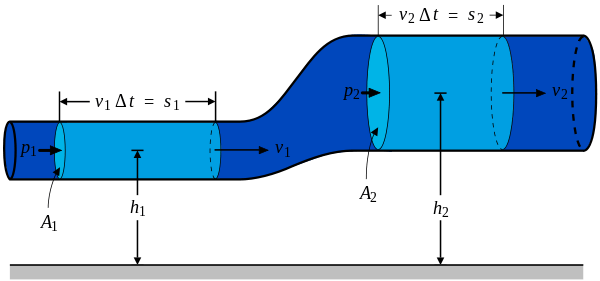Archimedes' principle
| Continuum mechanics | ||||
|---|---|---|---|---|
 | ||||
|
Laws
|
||||
Archimedes' principle indicates that the upward buoyant force that is exerted on a body immersed in a fluid, whether fully or partially submerged, is equal to the weight of the fluid that the body displaces and it acts in the upward direction at the centre of mass of the displaced fluid. Archimedes' principle is a law of physics fundamental to fluid mechanics. It was formulated by Archimedes of Syracuse.[1]
Explanation
In On Floating Bodies, Archimedes suggested that (c. 250 BC):
Any object, wholly or partially immersed in a fluid, is buoyed up by a force equal to the weight of the fluid displaced by the object.
Practically, the Archimedes' principle allows the buoyancy of an object partially or fully immersed in a liquid to be calculated. The downward force on the object is simply its weight. The upward, or buoyant force on the object is that stated by Archimedes' principle, above. Thus the net upward force on the object is the difference between the buoyant force and its weight. If this net force is positive, the object rises; if negative, the object sinks; and if zero, the object is neutrally buoyant - that is, it remains in place without either rising or sinking. In simple words, Archimedes' principle states that when a body is partially or completely immersed in a fluid, it experiences an apparent loss in weight which is equal to the weight of the fluid displaced by the immersed part of the body.
Formula
Consider a cube immersed in a fluid, with its sides parallel to the direction of gravity. The fluid will exert a normal force on each face, and therefore only the forces on the top and bottom faces will contribute to buoyancy. The pressure difference between the bottom and the top face is directly proportional to the height (difference in depth). Multiplying the pressure difference by the area of a face gives the net force on the cube – the buoyancy, or the weight of the fluid displaced. By extending this reasoning to irregular shapes we can see that, whatever shape of the submerged body, the buoyant force is equal to the weight of the fluid displaced. apparent loss in wt of water= wt of object in air-wt of object in water
The weight of the displaced fluid is directly proportional to the volume of the displaced fluid (if the surrounding fluid is of uniform density). The weight of the object in the fluid is reduced, because of the force acting on it, which is called upthrust. In simple terms, the principle states that the buoyant force on an object is equal to the weight of the fluid displaced by the object, or the density of the fluid multiplied by the submerged volume times the gravitational constant, g. Thus, among completely submerged objects with equal masses, objects with greater volume have greater buoyancy.
Suppose a rock's weight is measured as 10 newtons when suspended by a string in a vacuum with gravity acting on it. Suppose that when the rock is lowered into water, it displaces water of weight 3 newtons. The force it then exerts on the string from which it hangs would be 10 newtons minus the 3 newtons of buoyant force: 10 − 3 = 7 newtons. Buoyancy reduces the apparent weight of objects that have sunk completely to the sea floor. It is generally easier to lift an object up through the water than it is to pull it out of the water.
For a fully submerged object, Archimedes' principle can be reformulated as follows:
then inserted into the quotient of weights, which has been expanded by the mutual volume
yields the formula below. The density of the immersed object relative to the density of the fluid can easily be calculated without measuring any volume is
(This formula is used for example in describing the measuring principle of a dasymeter and of hydrostatic weighing.)
Example: If you drop wood into water, buoyancy will keep it afloat.
Example: A helium balloon in a moving car. When increasing speed or driving in a curve, the air moves in the opposite direction to the car's acceleration. However, due to buoyancy, the balloon is pushed "out of the way" by the air, and will actually drift in the same direction as the car's acceleration.
When an object is immersed in a liquid, the liquid exerts an upward force, which is known as the buoyant force, that is proportional to the weight of the displaced liquid. The sum force acting on the object, then, is equal to the difference between the weight of the object ('down' force) and the weight of displaced liquid ('up' force). Equilibrium, or neutral buoyancy, is achieved when these two weights (and thus forces) are equal.
Refinements
Archimedes' principle does not consider the surface tension (capillarity) acting on the body.[2] Moreover, Archimedes' principle has been found to break down in complex fluids.[3]
Principle of flotation
Archimedes' principle shows buoyant force and displacement of fluid. However, the concept of Archimedes' principle can be applied when considering why objects float. Proposition 5 of Archimedes' treatise On Floating Bodies states that:
Any floating object displaces its own weight of fluid.
In other words, for an object floating on a liquid surface (like a boat) or floating submerged in a fluid (like a submarine in water or dirigible in air) the weight of the displaced liquid equals the weight of the object. Thus, only in the special case of floating does the buoyant force acting on an object equal the objects weight. Consider a 1-ton block of solid iron. As iron is nearly eight times denser than water, it displaces only 1/8 ton of water when submerged, which is not enough to keep it afloat. Suppose the same iron block is reshaped into a bowl. It still weighs 1 ton, but when it is put in water, it displaces a greater volume of water than when it was a block. The deeper the iron bowl is immersed, the more water it displaces, and the greater the buoyant force acting on it. When the buoyant force equals 1 ton, it will sink no farther.
When any boat displaces a weight of water equal to its own weight, it floats. This is often called the "principle of flotation": A floating object displaces a weight of fluid equal to its own weight. Every ship, submarine, and dirigible must be designed to displace a weight of fluid at least equal to its own weight. A 10,000-ton ship must be built wide enough to displace 10,000 tons of water before it sinks too deep in the water. The same is true for vessels in air: a dirigible that weighs 100 tons needs to displace 100 tons of air. If it displaces more, it rises; if it displaces less, it falls. If the dirigible displaces exactly its weight, it hovers at a constant altitude.
It is important to realize that, while they are related to it, the principle of flotation and the concept that a submerged object displaces a volume of fluid equal to its own volume are not Archimedes' principle. Archimedes' principle, as stated above, equates the buoyant force to the weight of the fluid displaced.
One common point of confusion regarding Archimedes' principle is the meaning of displaced volume. Common demonstrations involve measuring the rise in water level when an object floats on the surface in order to calculate the displaced water.This measurement approach fails with a buoyant submerged object because the rise in the water level is directly related to the volume of the object and not the mass (except if the effective density of the object equals exactly the fluid density). Instead, in the case of submerged buoyant objects, the whole volume of fluid directly above the sample should be considered as the displaced volume. Another common point of confusion regarding Archimedes' principle is that it only applies to submerged objects that are buoyant, not sunk objects. In the case of a sunk object the mass of displaced fluid is less than the mass of the object and the difference is associated with the object's potential energy.
See also
- "Eureka", reportedly exclaimed by Archimedes upon discovery that the volume of displaced fluid is equal to the volume of the submerged object (note that this idea is not Archimedes' principle)
References
- ↑ Acott, Chris (1999). "The diving "Law-ers": A brief resume of their lives.". South Pacific Underwater Medicine Society journal. 29 (1). ISSN 0813-1988. OCLC 16986801. Retrieved 2009-06-13.
- ↑ "Floater clustering in a standing wave: Capillarity effects drive hydrophilic or hydrophobic particles to congregate at specific points on a wave" (PDF). 2005-06-23.
- ↑ "Archimedes’s principle gets updated". R. Mark Wilson, Physics Today 65(9), 15 (2012); doi: 10.1063/PT.3.1701
- ↑ "The works of Archimedes". p. 257. Retrieved 11 March 2010.
Any solid lighter than a fluid will, if placed in the fluid, be so far immersed that the weight of the solid will be equal to the weight of the fluid displaced.
